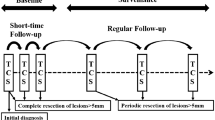Abstract
PURPOSE: Patients with familial adenomatous polyposis need prophylactic colectomy and ileorectal anastomosis or restorative proctocolectomy. Preoperative rectal polyp counts have been used as one factor to determine which operation should be done, triaging patients according to risk of rectal cancer or completion proctectomy after ileorectal anastomosis. This study was designed to examine the reliability of preoperative proctoscopy in predicting familial adenomatous polyposis severity and outcome after ileorectal anastomosis. METHODS: Familial adenomatous polyposis patients were categorized according to preoperative proctoscopy as follows: Group 1, 5 or fewer adenomas; Group 2, 6 to 19 adenomas; Group 3, 20 or more adenomas. Familial adenomatous polyposis severity was defined as mild if there were <1,000 polyps in the colon at colectomy and severe if there were >1,000 polyps. RESULTS: A total of 213 patients were reviewed, 80 in Group 1, 59 in Group 2, and 74 in Group 3. There was no difference among the groups in mean age at presentation. Patients with fewer than five rectal adenomas were predominately females. They rarely had symptoms (22.8 percent), had mostly mild polyposis (86.5 percent), and in 74 of 80 cases underwent ileorectal anastomosis. Only six underwent restorative proctocolectomy. Of those having an ileorectal anastomosis, five needed later proctectomy, none for cancer. Patients with 6 to 19 rectal polyps were a similar group to those with 5 or fewer. Most were asymptomatic (67.8 percent), most had mild polyposis (81.6 percent), and 54 of 59 underwent ileorectal anastomosis (5 had restorative proctocolectomy). Only 3 of the 54 having ileorectal anastomosis needed subsequent proctectomy, 2 for rectal cancer. The patients with 20 or more rectal polyps were different. They usually presented with symptoms (86 percent), the majority (56.6 percent) had severe polyposis, and only 50 percent (37/74) underwent ileorectal anastomosis, the other half having restorative proctocolectomy. Of the 37 patients with an ileorectal anastomosis, 13 needed later proctectomy (35.1 percent), 4 for cancer (10.8 percent). CONCLUSION: Fewer than five rectal adenomas at presentation almost always predicts mild disease, and patients do well after ileorectal anastomosis. Twenty or more adenomas usually means severe disease. Patients with 6 to 19 adenomas are often mildly affected, but their phenotype is less benign than that of patients with fewer than five polyps. Although not foolproof, proctoscopy is a useful test in triaging patients with familial adenomatous polyposis according to disease severity.
Similar content being viewed by others
References
Wu JS, Paul P, McGannon EA, Church JM. APC genotype, polyp number and surgical options in familial adenomatous polyposis. Ann Surg 1998;227:57–62.
Sarre RG, Jagelman DG, Beck GJ,et al. Colectomy with ileorectal anastomosis for familial adenomatous polyposis: the risk of rectal cancer. Surgery 1987;101:20–6.
Debinski HS, Love S, Spigelman AD, Phillips RK. Colorectal polyp counts and cancer risk in familial adenomatous polyposis. Gastroenterology 1996;110:1028–30.
Bertario L, Russo A, Radice P,et al. Genotype and phenotype factors as determinants for rectal stump cancer in patients with familial adenomatous polyposis. Hereditary Colorectal Tumors Registry. Ann Surg 2000;231:538–43.
Nugent KP, Phillips RK, Rectal cancer risk in older patients with familial adenomatous polyposis and an ileorectal anastomosis: a cause for concern. Br J Surg 1992;79:1204–6.
Bess MA, Adson MA, Elveback LR, Moertel CG. Rectal cancer following colectomy for polyposis. Arch Surg 1980;121:460–7.
Harvey JC, Quan SH, Stearns M. Management of familial polyposis with preservation of the rectum. Surgery 1978;84:476–82.
Slors JF, den Hartog Jager FC, Trum JW, Taat CW, Brummelkamp WH. Long-term follow-up after colectomy and ileorectal anastomosis in familial adenomatous polyposis coli. Is there still a place for the procedure? Hepatogastroenterology 1989;36:109–12.
Tonelli F, Valanzano R, Monaci I, Mazzoni P, Anasti A, Ficari F. Restorative proctocolectomy or rectumpreserving surgery in patients with familial adenomatous polyposis: results of a prospective study. World J Surg 1997;21:653–9.
Author information
Authors and Affiliations
Additional information
Read at the meeting of The American Society of Colon and Rectal Surgeons, Boston, Massachusetts, June 24 to 29, 2000.
About this article
Cite this article
Church, J., Burke, C., McGannon, E. et al. Predicting polyposis severity by proctoscopy. Dis Colon Rectum 44, 1249–1252 (2001). https://doi.org/10.1007/BF02234779
Issue Date:
DOI: https://doi.org/10.1007/BF02234779




